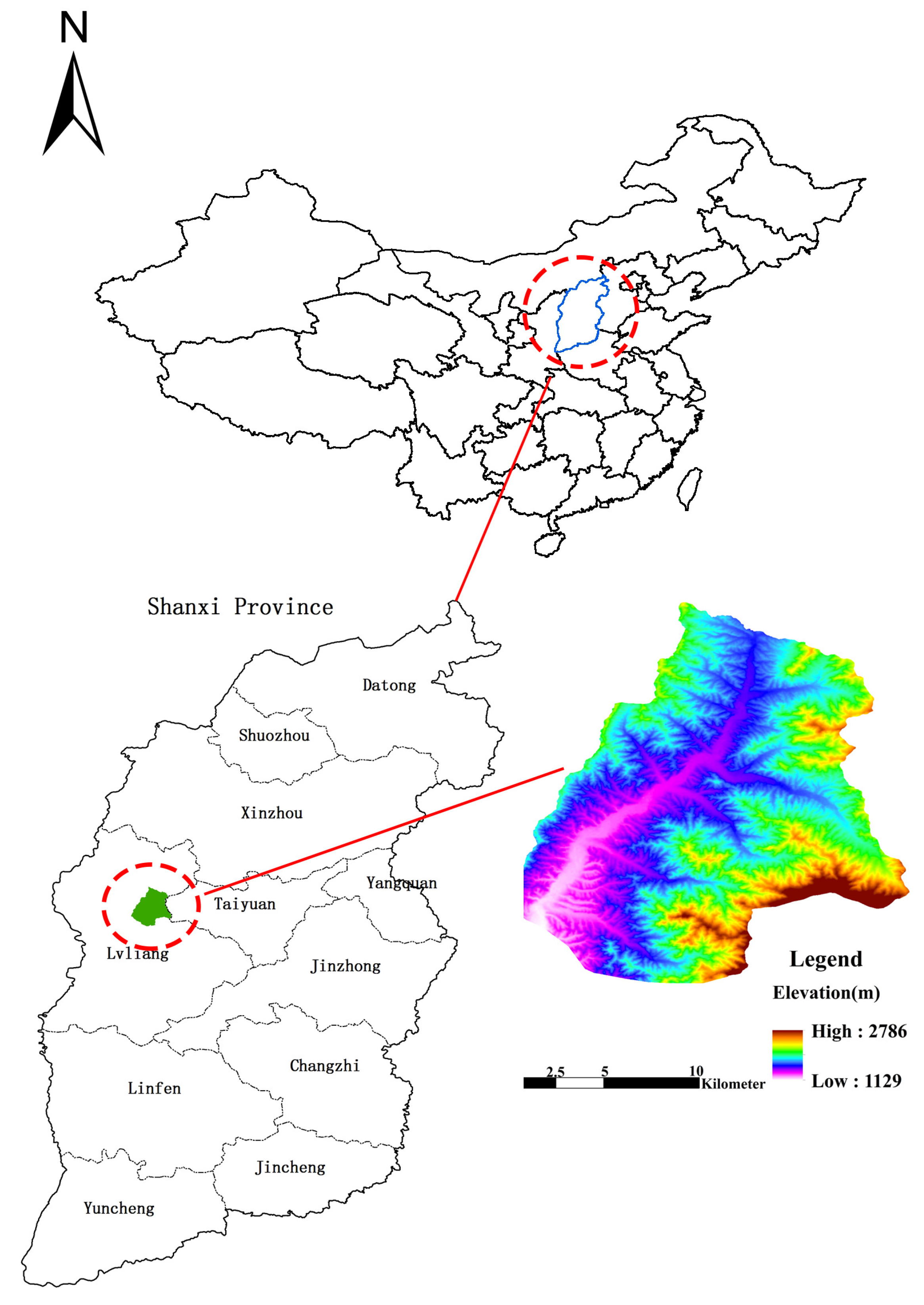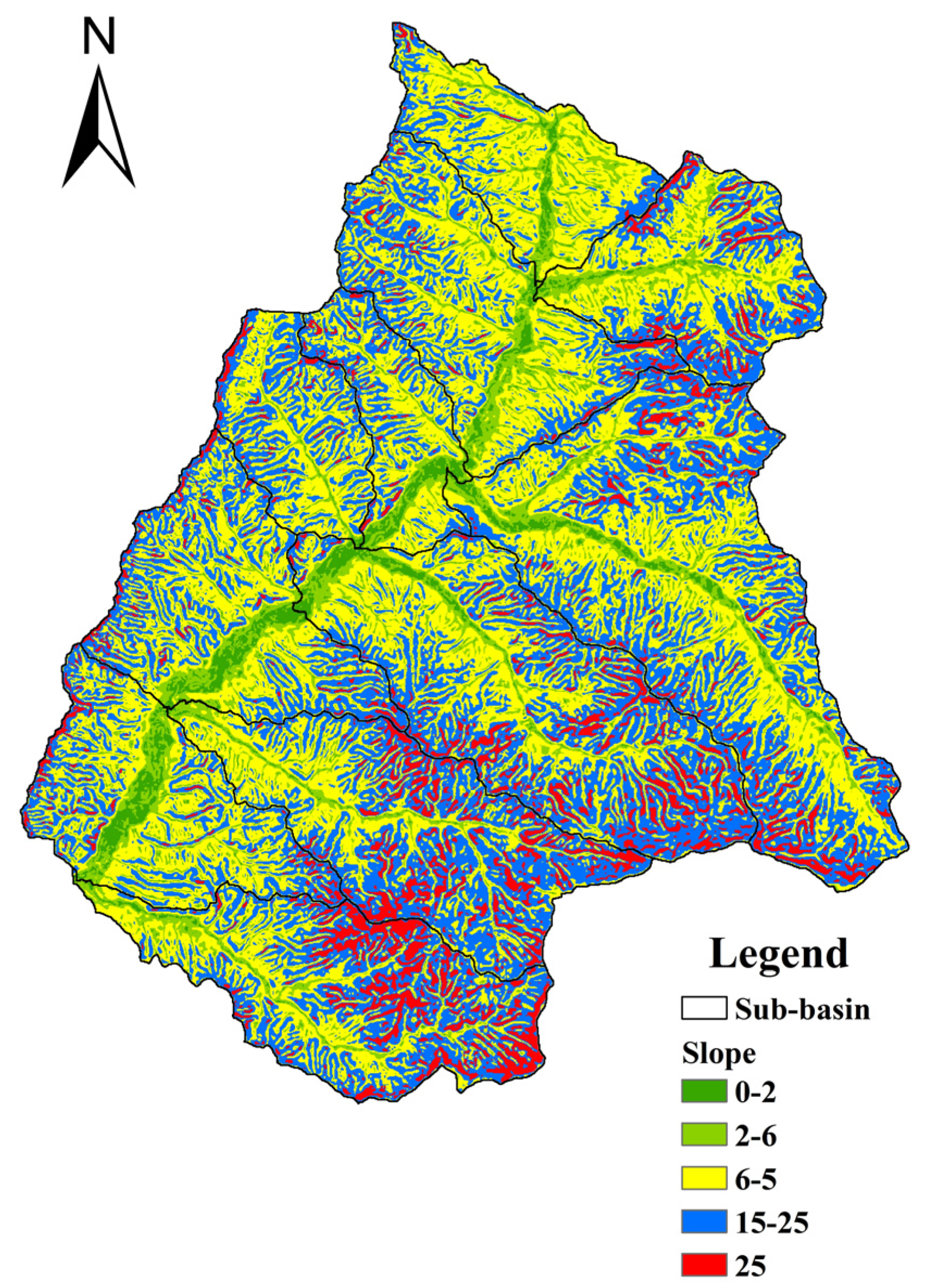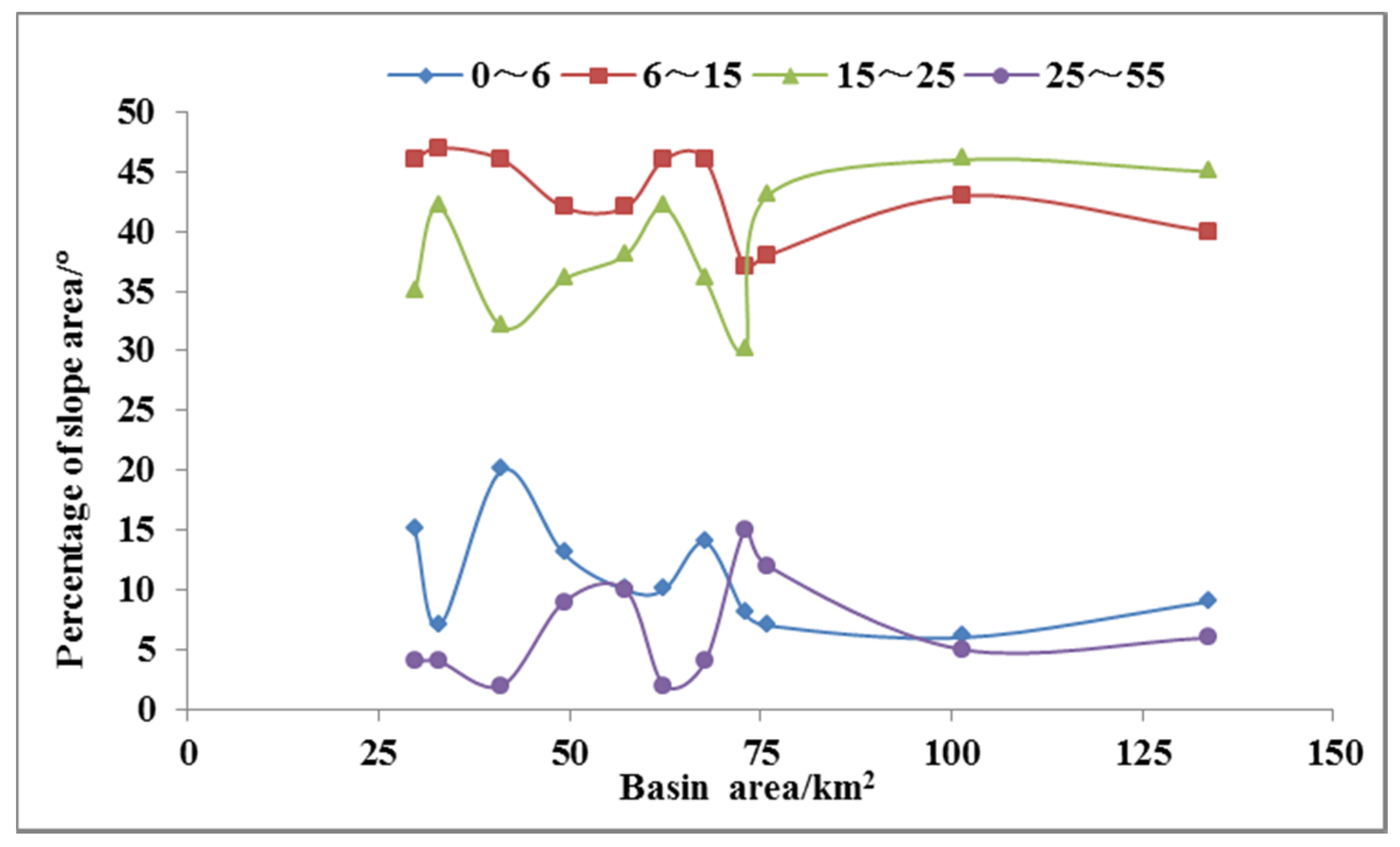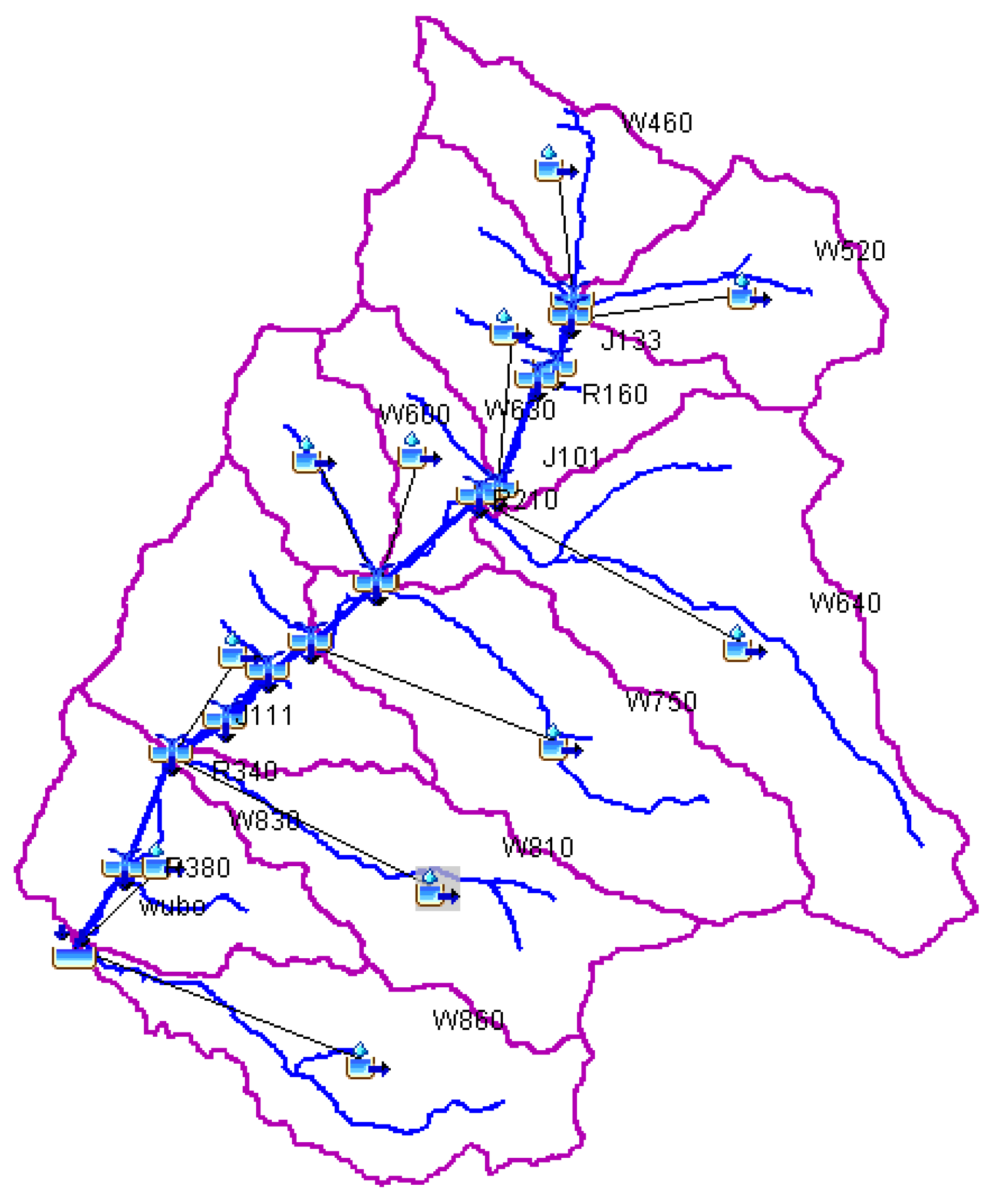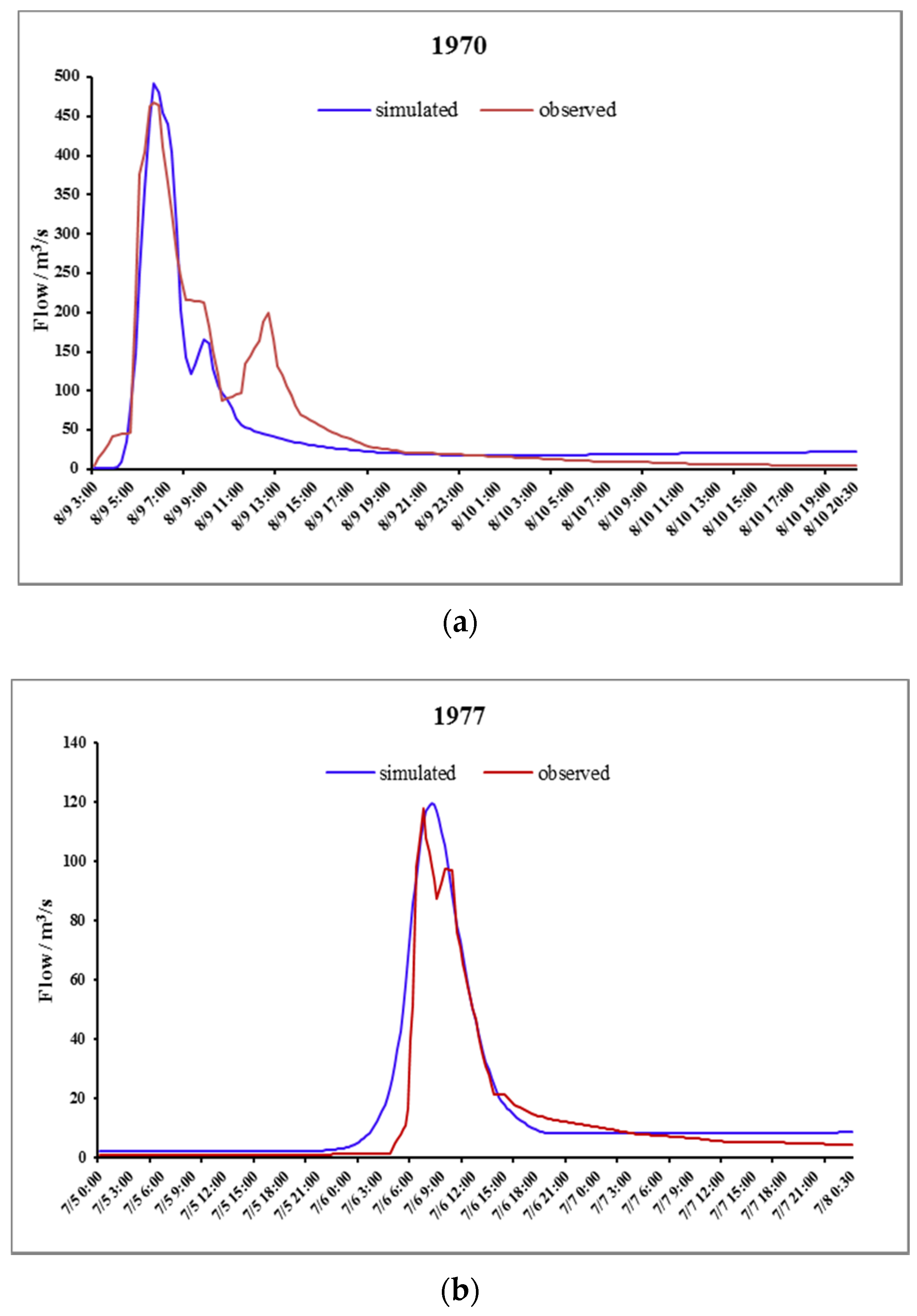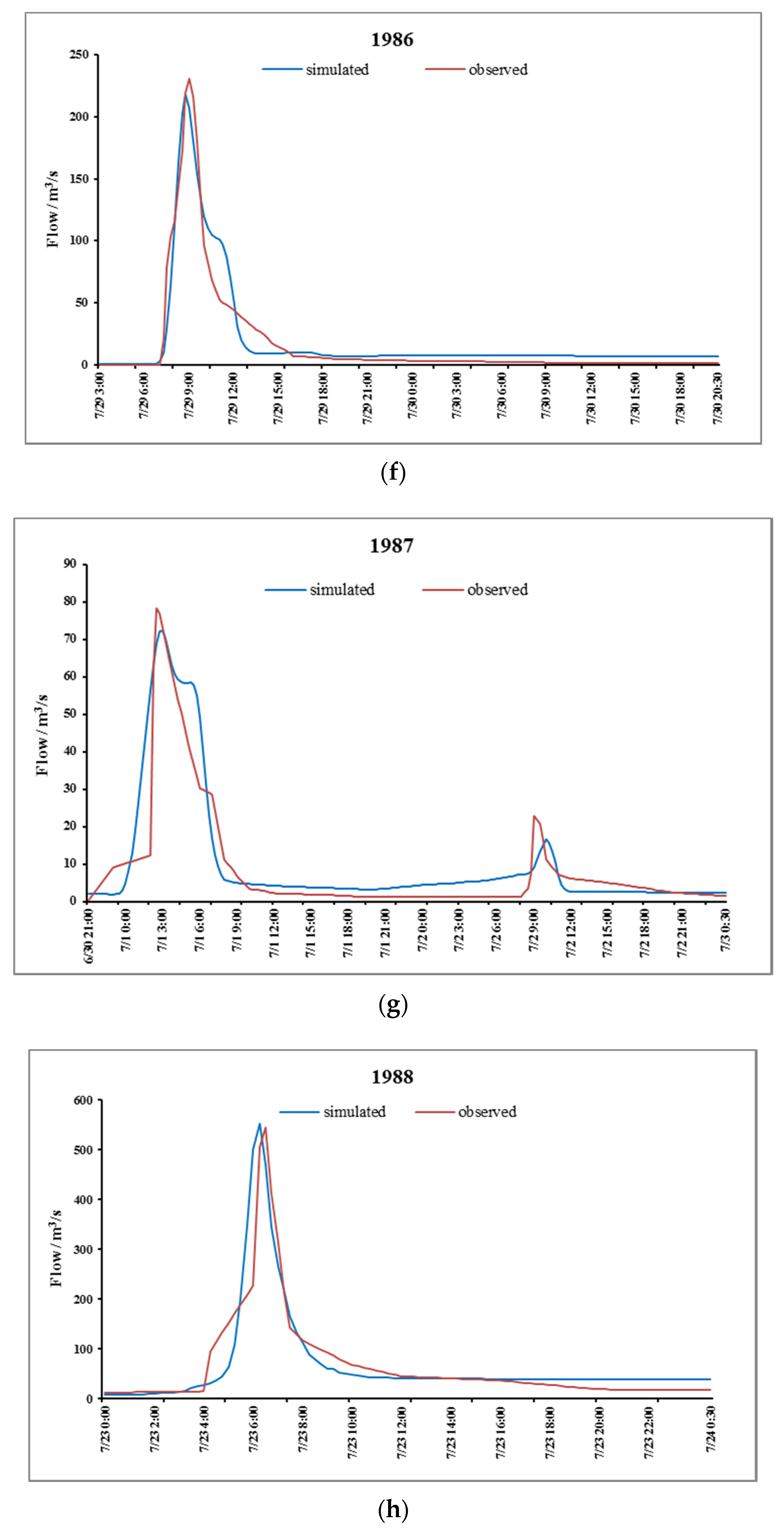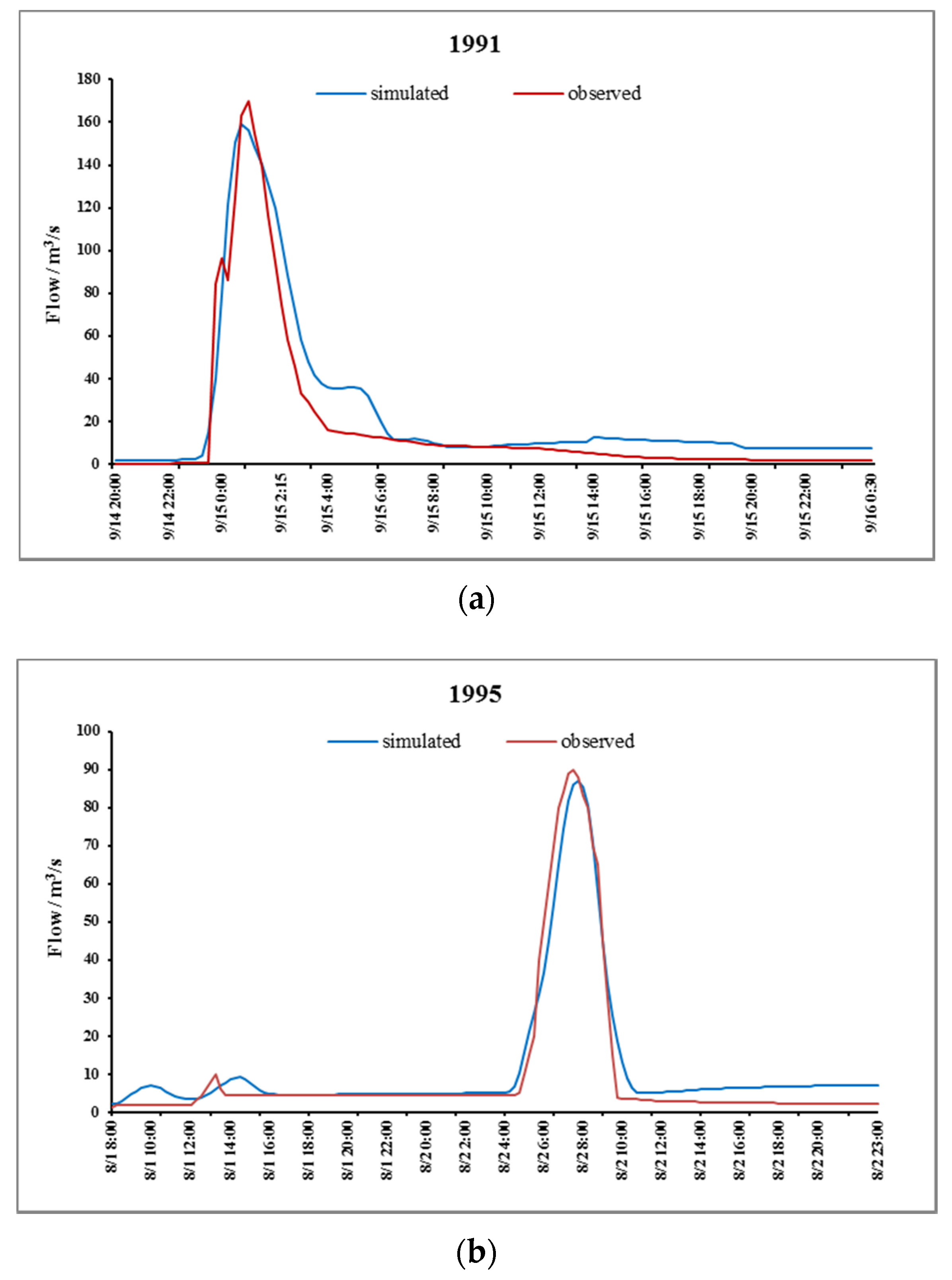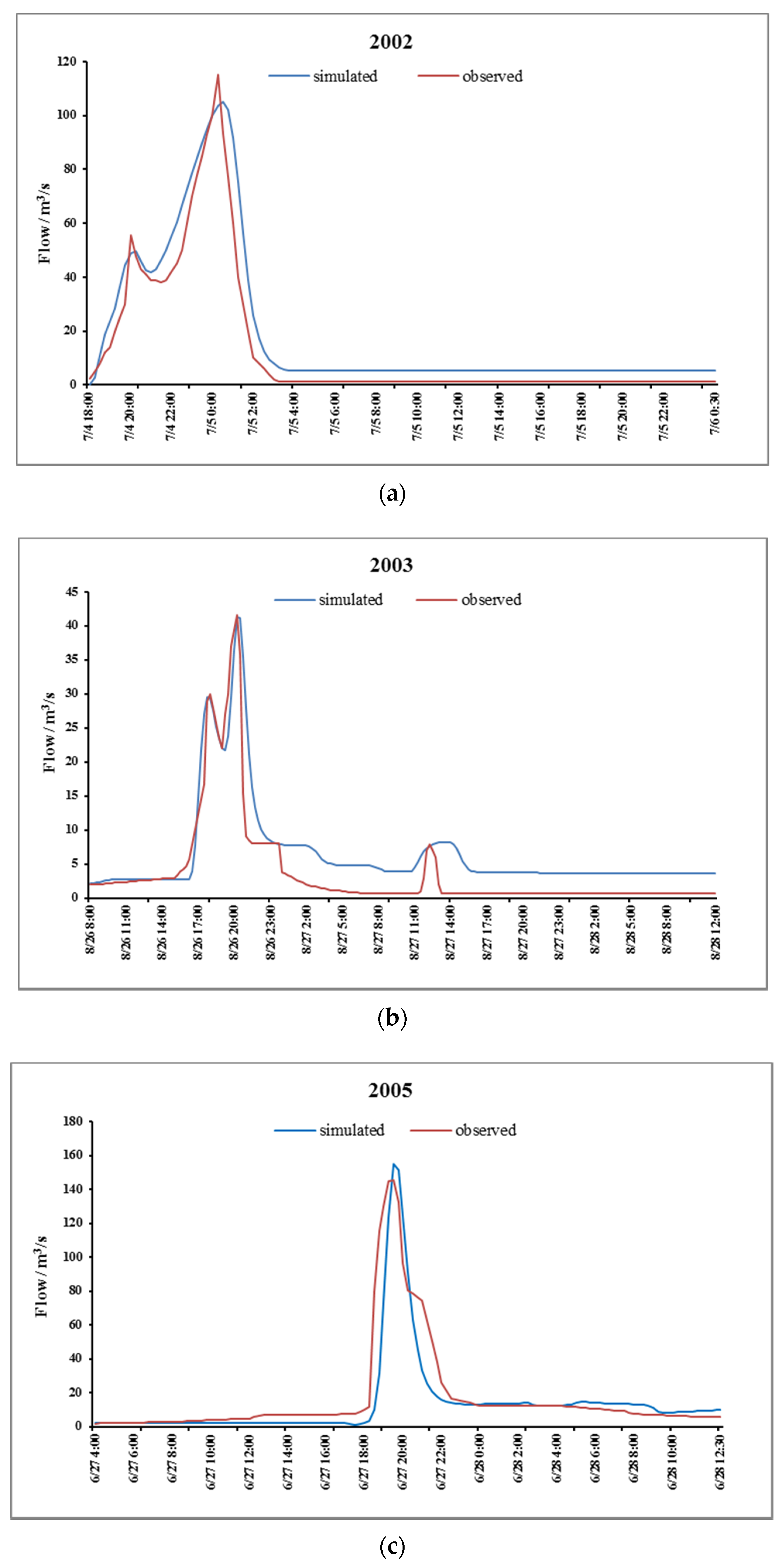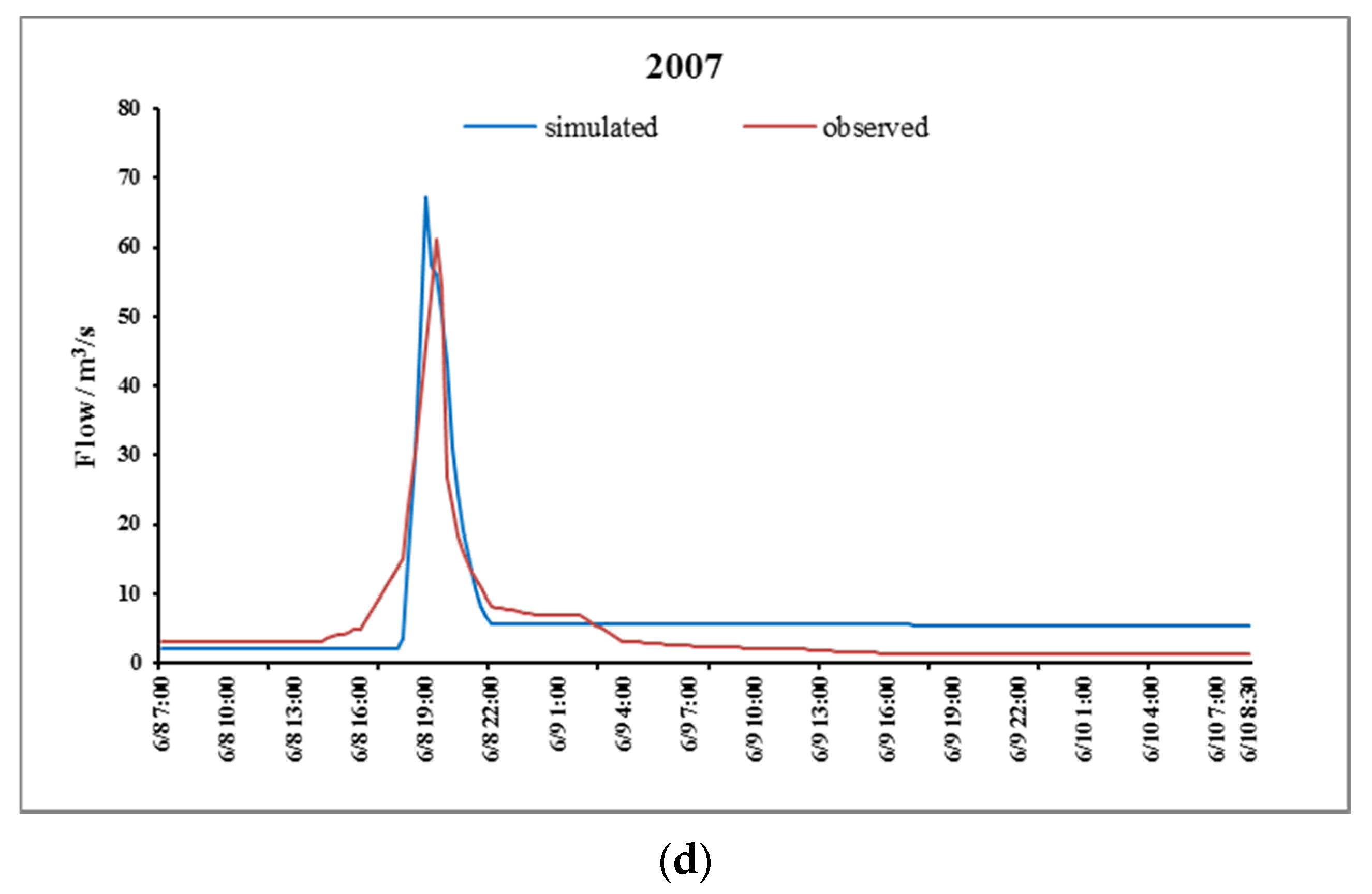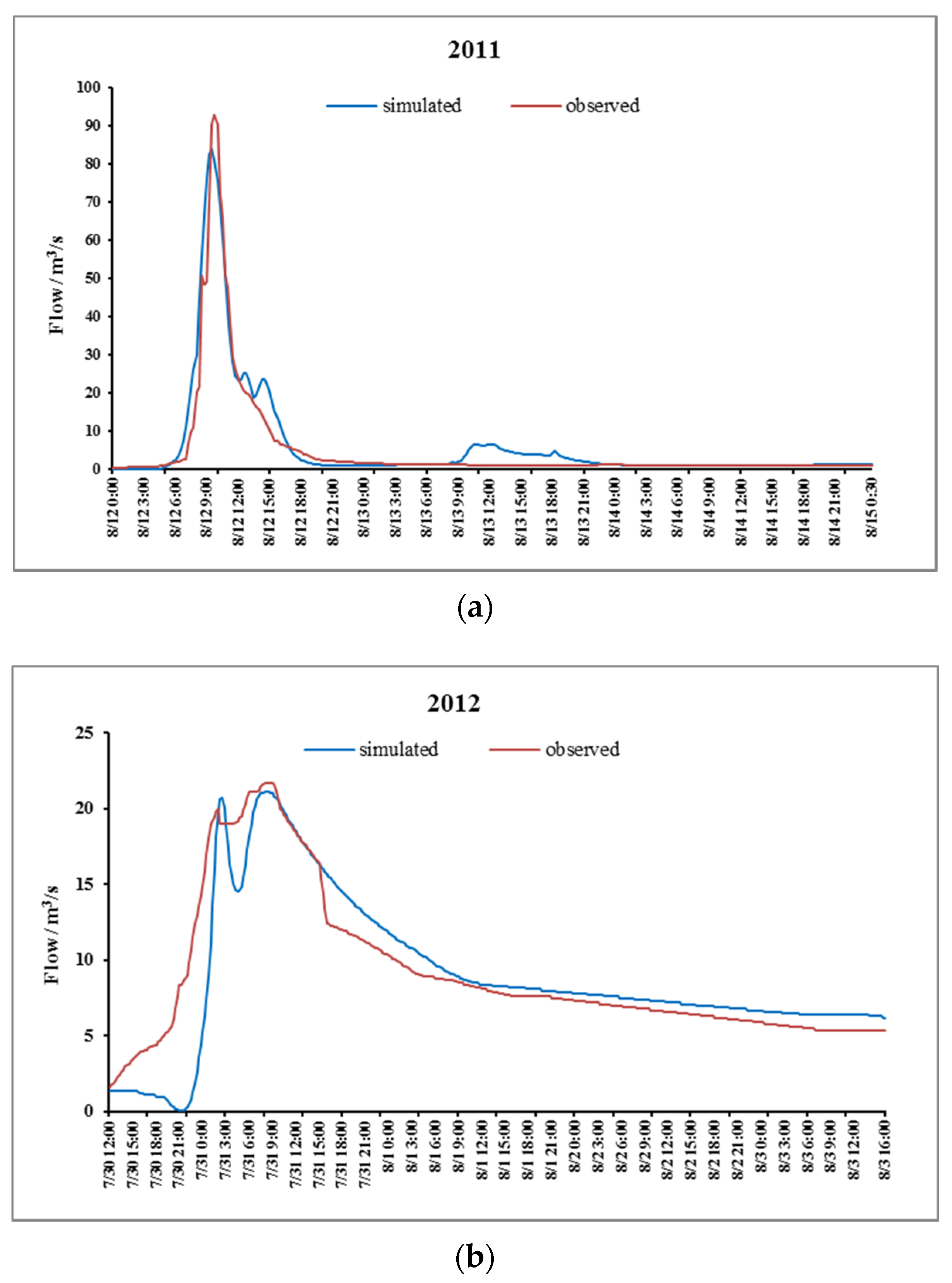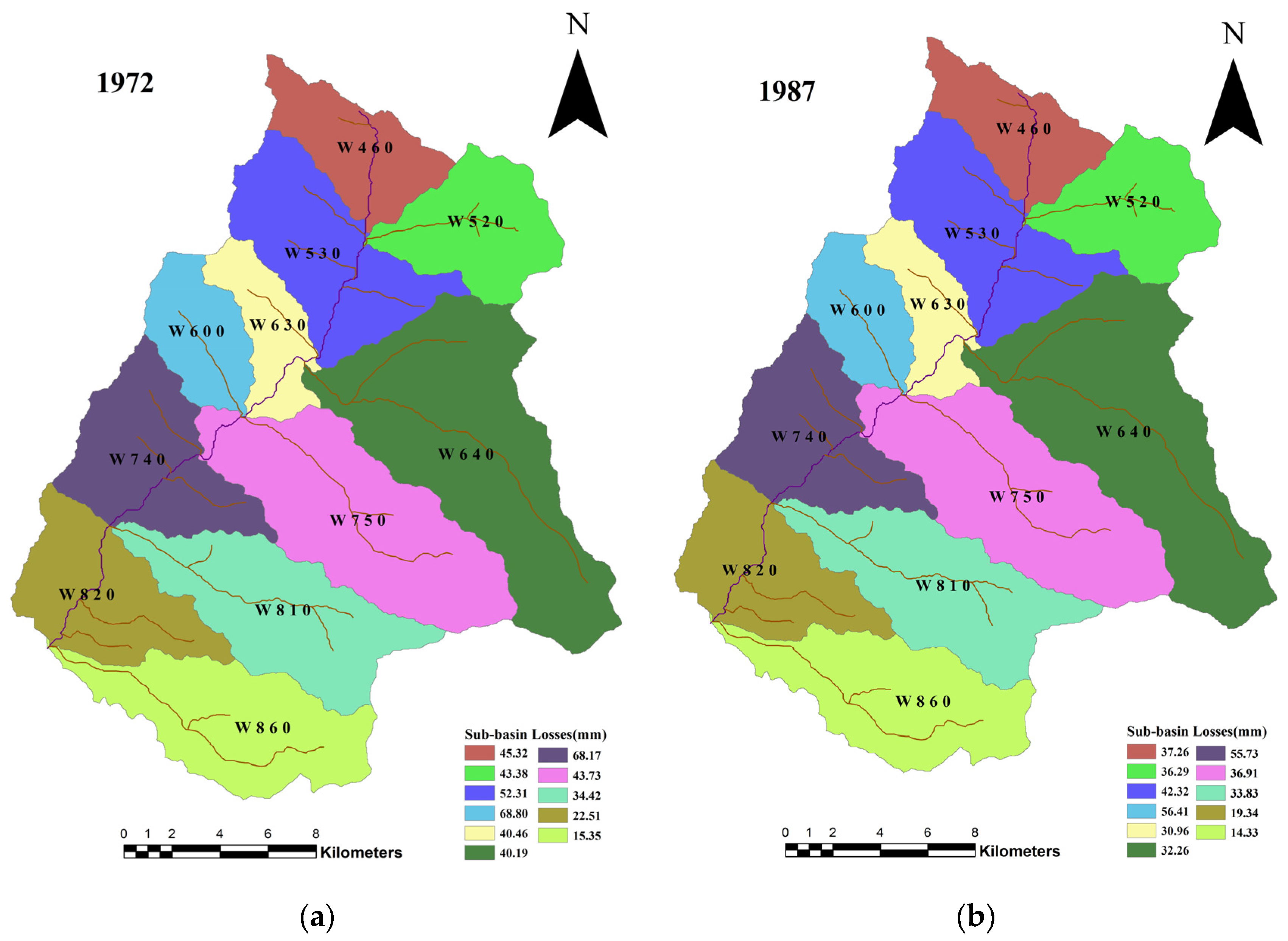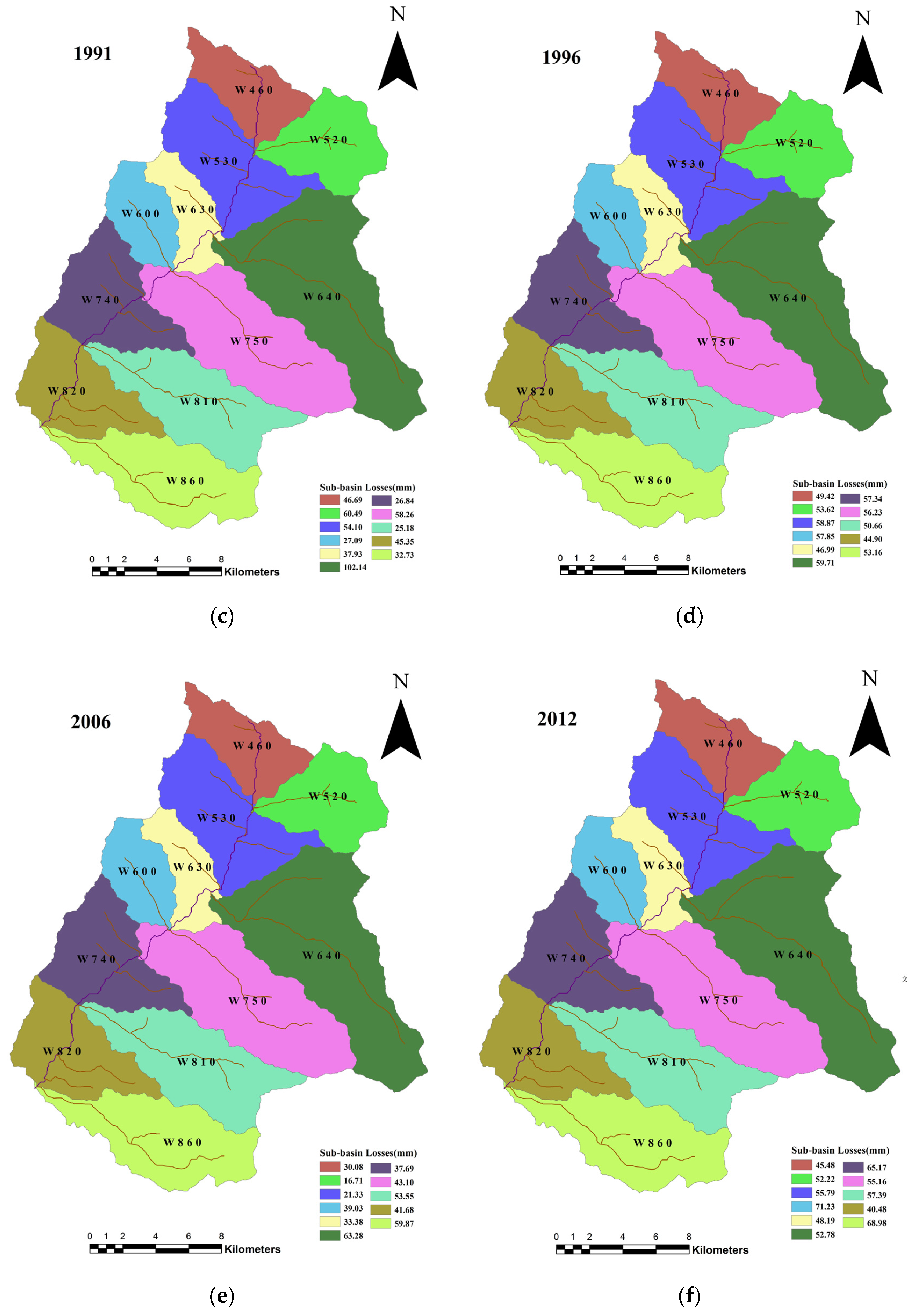1. Introduction
Rainfall losses, which occur during flood events, play a crucial role in real-time flood forecasting and flood estimation [
1,
2]. The losses are generated through canopy interception, infiltration, depression storage, evaporation, and evapotranspiration [
3]. Rainfall losses by canopy interception are a significant part of hydrological losses from forested ecosystems. Rainfall interception losses mainly rely on the rainfall characteristics, forest structure, and climatic changes governing the rates of evaporation and evapotranspiration during and after rainfall events [
4,
5]. Infiltration is a major process in flood generation. Infiltration rate is a function of antecedent soil moisture content that decides the magnitude of flood peak and volume [
6]. In semi-arid agricultural areas, evaporation and evapotranspiration from the soil have a significant impact on rainfall losses [
7]. However, the underlying surface is a paramount factor affecting rainfall losses during flood events. The effect of the underlying surface on rainfall losses is different because of its vegetation, slope, and tillage measures. It is considered that vegetation might prevent rainfall from reaching the surface due to canopy interception and infiltration; the surface slope is large, the flow speed is fast, and its retention time is short, leading to a small infiltration amount. Tillage measures (terrace) change the slope micro-terrain and increase the roughness so that soil moisture infiltration performance changes, thus affecting rainfall losses. In short, the underlying surface can affect the rainfall losses by interception and infiltration in the flood process [
8].
In recent years, many studies have been conducted to examine the relationship between rainfall losses and land use type with different models. The Gash model [
9] was applied to the basin covered by sugarcane and riparian forest in order to assess the influence of rapid sugarcane canopy changes on rainfall interception losses and explain the main factors determining the rainfall interception losses [
10]. The Liu model [
11] was used in an experimental multispecies (
Acacia mangium,
Gliricidia sepium,
Guazuma ulmifolia,
Ochroma pyramidale, and
Pachira quinata) tree plantation in Soberania National Park to predict rainfall interception losses and estimate the water storage capacities of tree boles; the results revealed that the interspecific differences between observed and simulated cumulative interception loss were significant, with
Acacia mangium intercepting more rainfall than other species. The Liu model was most sensitive to variations of evaporation rate [
12]. In a mixed evergreen and deciduous broadleaved forest, the rainfall interception loss predictions of the revised Gash model were evaluated and the magnitude of gross precipitation and its distribution into interception losses, through fall and stemflow were quantified [
13]. In a word, many investigations concerning rainfall losses focused on vegetation interception, while infiltration research was relatively scarce. Gedong basin is a typical loess hilly–gully region; a number of studies in loess hilly–gully regions focus on soil erosion and soil loss. Feng et al. [
14] compared the soil and water conservation performances under three single land use types (cultivated land, CL; switchgrass, SG; and abandoned land, AL) and two composite land use types (CL–SG and CL–AL). The results indicated a general trend in the number of runoff and soil loss events for the five land-use types: CL = CL–SG > CL–AL > SG > AL, and the vegetation coverage was the primary factor controlling soil erosion. Zhang et al. [
15] analyzed the influences of the thickness of an aeolian sand layer overlying a loess slope on runoff and sediment production processes by eight simulated rainstorms in the Wind–Water Erosion Crisscross Region of the northern Loess Plateau. Zhu et al. [
16] combined three sets of plot data (short slope plots, long slope plots, and soil conservation plots) to evaluate the effectiveness of different conservation measures in reducing runoff and soil loss. Yan et al. [
17] explored the effect of watershed management practices on the relationship between runoff and sediment by analyses in the hilly–gully regions of the Loess Plateau; the results suggested that a combination of hillslope and gully erosion control practices effectively reduced sediment delivery and erosion. Li et al. [
18] determined the effect of different land use types (artificial forestland, native grassland, and artificial grassland) on soil organic carbon and total soil nitrogen by experimental and statistical analysis; the results showed that land use types had great influence on soil organic carbon and total soil nitrogen, and artificial grassland was the optimal choice to mitigate soil carbon and nitrogen loss in the loess hilly–gully region.
In summary, a majority of previous studies in the loess hilly–gully region concentrated on soil loss and erosion; only a few studies have analyzed rainfall losses with a focus on vegetation interception. In the Gedong basin, most rainfall losses are generated through interception and infiltration. Hence the sub-basins’ rainfall losses (interception and infiltration) under different underlying surface conditions are determined in this study by the HEC-HMS model (Hydrologic Engineering Center-Hydrological Model System,U.S. Army Corps of Engineers–Hydrologic Engineering Center,Washington, DC, USA).
At present, the HEC-HMS model has been widely applied to flood simulation [
19], flood forecasting [
20,
21,
22], flood frequency analysis [
23], flood plain and hazard [
24], flood warning [
25], and the impact of climate change, land use change, and human activities on runoff [
26,
27,
28,
29]. The HEC-HMS model has different methods to calculate the rainfall losses such as Soil and Conservation Service, Green and Ampt, Initial-Constant, Deficit-Constant, Exponential and Soil Moisture Accounting [
6]. The Soil and Conservation Service (SCS) Curve Number (CN) loss model estimates precipitation excess as a function of cumulative precipitation, land use, soil cover, and antecedent soil moisture [
6]. The CN can reflect the underlying condition of the basin. Considering CN can reflect the underlying characteristics of the basin, the SCS-CN loss method is applied to this study.
The objective of this study is to analyze the relationship between the rainfall losses and underlying characteristics in the hilly–gully loess region. The underlying characteristics include vegetation, soil, slope, and so on. In this study, the SCS-CN loss model is used to calculate the rainfall losses of sub-basins in different underlying surface conditions, and then the relationship between the rainfall losses and underlying characteristics (the percentage of forestland area and surface slope in sub-basins) is analyzed on the basis of rainfall losses calculation results and existing experimental results in the loess hilly–gully region.
4. Results and Discussions
4.1. Model Construction and Simulation
The Gedong basin is divided into 11 sub-basins in order to better represent the spatial variation of parameters. The hydrological model requires that each sub-basin has at least one rainfall node that could represent the sub-basin. In this study, the centroid of the sub-basin was selected as the rainfall node of each sub-basin. The convergence lines of the two sub-basins formed the river channel, until the basin exit section. A generalized model of Gedong basin is shown in
Figure 7.
4.2. Sensitivity Analysis
In this study, 18 flood events in different stages were applied to the simulation. A sensitivity analysis was used to examine the relative changes in the model outputs with respect to the change in the model input parameters [
41]. Theoretically, if
x1,
x2,…,
xn were model input variables and y =
y(
x1,
x2,…,
xn) was the model output, then the relative sensitivity (flexibility) of y with respect to the
ith variable at (
x1,…,
x′
i,…,
xn) was equal to
If the absolute value of e was equal to or greater than 1, the model input parameter was flexible. Otherwise, the model input parameter was weakly flexible or inflexible [
45,
46]. Sensitivity analysis was performed in two stages. The impact of CN (curve number), I
a (initial abstraction), RC (attenuation coefficient), R (peak ratio), K (travel time), X (weighting factor of flow), and t
lag (lag time) on the peak discharge (P) and the impact of CN, I
a, RC, R, K, X, and t
lag on flood volume (V) were assessed in the first and second stages, respectively [
46]. The results of the sensitivity analysis are shown in
Table 3.
The sensitivity analysis illustrated that CN, Ia, tlag, and K were sensitive to the peak discharge and flood volume in a loess hilly region such as Gedong basin.
The parameters that were consistent with the flood events of the 1970s and 1980s observed in the hydrograph are shown in
Table 4.
The observed and simulated hydrographs of the 1970s and 1980s are shown in
Figure 8.
Overall, the figures described the shape and trend of the hydrographs of eight flood events as being similar, except 1970 and 1977. The total volume was slightly overestimated based on the observed hydrograph in 1977. The peak was slightly underestimated based on the observed hydrograph in 1982, 1986, and 1987, while a relatively perfect match was obtained in 1979.
The parameters that were consistent with the flood events of the 1990s in the observed hydrograph are shown in
Table 5.
The observed and simulated hydrographs of 1990s are shown in
Figure 9.
On the whole, the figures described the shape and trend of the hydrographs of four flood events as being similar. However, the peak of all events was slightly underestimated based on the observed hydrograph.
The parameters that were consistent with the flood events of the 2000s in the observed hydrograph are shown in
Table 6.
The observed and simulated hydrographs of the 2000s are shown in
Figure 10.
In contrast to the hydrographs of the 1970s, 1980s, and 1990s, similar results were obtained in the 2000s. The shape and trend of the hydrographs of four flood events were similar. The total volume was slightly overestimated based on the observed hydrographs of 2002 and 2003. The peak was slightly overestimated based on the observed hydrographs in 2005 and 2007.
The parameters that were consistent with the flood events of the 2010s in the observed hydrograph are shown in
Table 7.
The observed and simulated hydrographs of the 2010s are shown in
Figure 11.
It can be seen that the fitness between the simulated and observed hydrographs was less precise than other periods, especially in 2012. This is because, after 2010, the forestland area changed greatly, resulting in great changes of parameters and their underlying characteristics. Moreover, in the SCS model, soil initial moisture was classified into dry, moderate, and wet; such a simple and coarse classification might also lead to increased error during the flood simulation process [
6].
Model simulated results and evaluation criteria [
47] for 18 flood events are summarized in
Table 8.
It can be seen from
Table 8 that the peak flood absolute error between the observed and simulated peak discharge ranged from 0.56% to 18.49%, and the peak current difference ranged from 0 to 1 h. Moreover, the Nash coefficient was higher than 0.7, and the maximum value was 0.81. In summary, the HEC-HMS model was suitable for flood simulation of a loess hilly region in Gedong basin.
4.3. Calculation of Losses in Sub-Basins
Losses in the study area were calculated in the sub-basin for 1972, 1987, 1991, 1996, 2006, and 2012. They represented the underlying characteristics of different ages. The percentage of forestland in each sub-basin and sub-basin area is shown in
Table 9.
According to the “Standard for hydrological information and hydrological forecasting (GB/T 22482-2008),” in this work we proposed four model performance classes as a guidance on reference Nash coefficient range, which were denoted as Unsatisfactory (Nash coefficient < 0.5), Acceptable (0.5 ≤ Nash coefficient < 0.7), Good (0.7 ≤ Nash coefficient < 0.9), or Very good (Nash coefficient ≥ 0.9) [
48]. The Nash coefficients of 19 July 1972, 30 June 1987, 15 September 1991, 9 August 1996, 14 August 2006, and 30 July 2012 used for the calculation of rainfall losses, as shown in
Table 10.
Table 10 illustrates that the probability of the model fit being considered Unsatisfactory, Acceptable, Good, and Very good was 0%, 16.67%, 83.33%, and 0%, respectively. So the calculation of rainfall losses was feasible.
Table 11 demonstrates that the total precipitation volume generated in the whole basin was 590.47 mm and the loss volume was 474.63 mm, with an average percentage of 80.38% per sub-basin. The losses of W630, W520, W460, and W830 were below the average value.
Table 12 showed that the total precipitation volume generated in the whole basin was 487.79 mm and the loss volume was 395.64 mm, with an average percentage of 81.11% per sub-basin. The losses of W630, W520, W460, and W830 were below average.
Table 13 shows that the total precipitation volume generated in the whole basin was 623.08 mm and the loss volume was 516.81 mm, with an average percentage of 82.94% per sub-basin. The losses of W630, W520, W460, and W830 were below average value.
Table 14 shows that the total precipitation volume generated in the whole basin was 706.35 mm and the loss volume was 588.74 mm, with an average percentage of 83.35% per sub-basin. The losses of W630, W520, W460, and W830 were below average value.
Table 15 illustrates that the total precipitation volume generated in the whole basin was 499.77 mm and the loss volume was 439.7 mm, with an average percentage of 87.98% per sub-basin. The losses of W740, W630, W520, W460, and W830 were below average value.
Table 16 shows that the total precipitation volume generated in the whole basin was 680.47 mm and the loss volume was 612.87 mm, with an average percentage of 90.07% per sub-basin. The losses of W740, W630, W520, W460, and W830 were below average value.
The spatial distribution of the sub-basin rainfall losses is shown in
Figure 12.
On the whole, with the increase of forestland percentage, the rainfall losses in the watershed increased from 1972 to 2012. In 1972, the variation range of the rainfall losses of sub-basins was 70.61% to 90.96% and the average percentage of the rainfall losses of sub-basins was 80.38%; in 1987, the variation range was 71.50% to 90.98% and the average percentage of the rainfall losses of sub-basins was 81.11%; in 1991, the variation range was 72.25% to 91.56% and the average percentage of the rainfall losses of sub-basins was 82.94%; in 1996, the variation range was 72.29% to 92.11% and the average percentage of the rainfall losses of sub-basins was 83.35%; in 2006, the variation range was 74.45% to 98.02% and the average percentage of the rainfall losses of sub-basins was 87.98%; in 2012, the variation range was 74.56% to 98.69% and the average percentage of the rainfall losses of sub-basins was 90.07%.
4.4. The Relationship between Rainfall Losses and Forestland Percentage and Slope
According to the experiment in Wangjiagou (a semi-arid hilly loess region of Shanxi Province of China), with an increase of slope angles, the runoff per unit area slightly increased on a short slope (7 m long), but decreased after reaching a maximum at 15° and then decreased with slope angle on a long slope (20 m long), which might be related to the complicated effect of several factors (e.g., rainfall conditions, rill development) on soil infiltrability [
16]. In general, with the increase in slope, the rainfall losses gradually decreased. Moreover, for different rainfall periods, about 15° below the slope, slope had a greater impact on infiltration, while a slope greater than 15° had less influence on infiltration [
49]. The results revealed that the rainfall losses’ decline was largest at 15°, and the effect of slope on rainfall losses was complex. Thus, rainfall losses were influenced by forestland percentage and slope in Gedong basin. Multiple regression analysis was used to analyze the effects of forestland percentage and slope on rainfall losses in different sub-basins. The results suggested that the effect of forestland on rainfall losses was greater than that of slope, and rainfall losses increased as the forestland percentage increased and slope decreased. The regression equation was as follows:
When the slope was [0, 15°],
When the slope was [15, 55°],
where y represents rainfall losses, x
1 represents the surface slope, and x
2 represents forestland.
As shown in regression Equations (14) and (15), the result of multiple regression analysis was similar to the experimental result in loess hilly regions [
49].
4.5. The Impact of Forestland Percentage on Rainfall Losses
In the Wangjiagou basin (a typical loess hilly region), Li Gang et al. [
49] obtained the infiltration characteristics of different land types through a rainfall infiltration experiment. The steady infiltration rate of forestland was 0.96–0.99 mm/min, and the steady infiltration rate of cultivated land was 0.39–0.83 mm/min (the higher the slope of cultivated land, the lower the infiltration rate). This indicated that the infiltration rate of forestland was higher than that of cultivated land. So forestland was the main factor influencing rainfall losses in loess hilly regions.
According to the slope analysis, the areas of W740, W630, W520, W460, and W830 were all less than 75 km
2, so the slope of these sub-basins was mainly 6–15°. In these sub-basins, rainfall losses should be higher than in other sub-basins. However, the losses of W740, W630, W520, W460, and W830 were below the average value in
Table 11,
Table 12,
Table 13,
Table 14,
Table 15 and
Table 16, which was caused by the percentage of forestland in these sub-basins being relatively lower than in others.
The correlation between rainfall losses and percentage of forestland in sub-basins was analyzed under the same rainfall level and different underlying conditions. According to the level of rainfall (30–40 mm; 40–50 mm; 50–60 mm), the flood events were categorized into 19 July 1972 (54.6 mm) and 14 September 1991 (56.4 mm), 30 June 1987 (42.5 mm) and 14 August 2006 (43.6 mm), 9 August 1996 (60.13 mm) and 30 July 2012 (61.61 mm). In
Table 11,
Table 12,
Table 13,
Table 14,
Table 15 and
Table 16, rainfall losses in 14 September 1991 were 42.18 mm more than 19 July 1972, 14 August 2006 were 44.74 mm more than 30 June 1987, and 30 July 2012 were 24.13 mm more than 9 August 1996, respectively. The results were consistent with the view that the rainfall losses had a positive correlation with forestland percentage. In contrast, the flood volume had a negative correlation with forestland percentage. The information of losses per sub-basin was similar to the information on flood contributing areas. The results of this information were helpful to determine the water availability of different areas. The correlation between rainfall losses and percentage of forestland in sub-basins is shown in
Figure 13.
From the 1970s to the 2010s, with the increase of forestland, the correlation coefficient between the percentage of rainfall losses and the percentage of forestland gradually increased. The correlation coefficient of 1972 was lower (0.64). In 2012, the correlation coefficient reached 0.84, which indicates that the rainfall losses of the basin had a positive correlation with the percentage of forestland.
